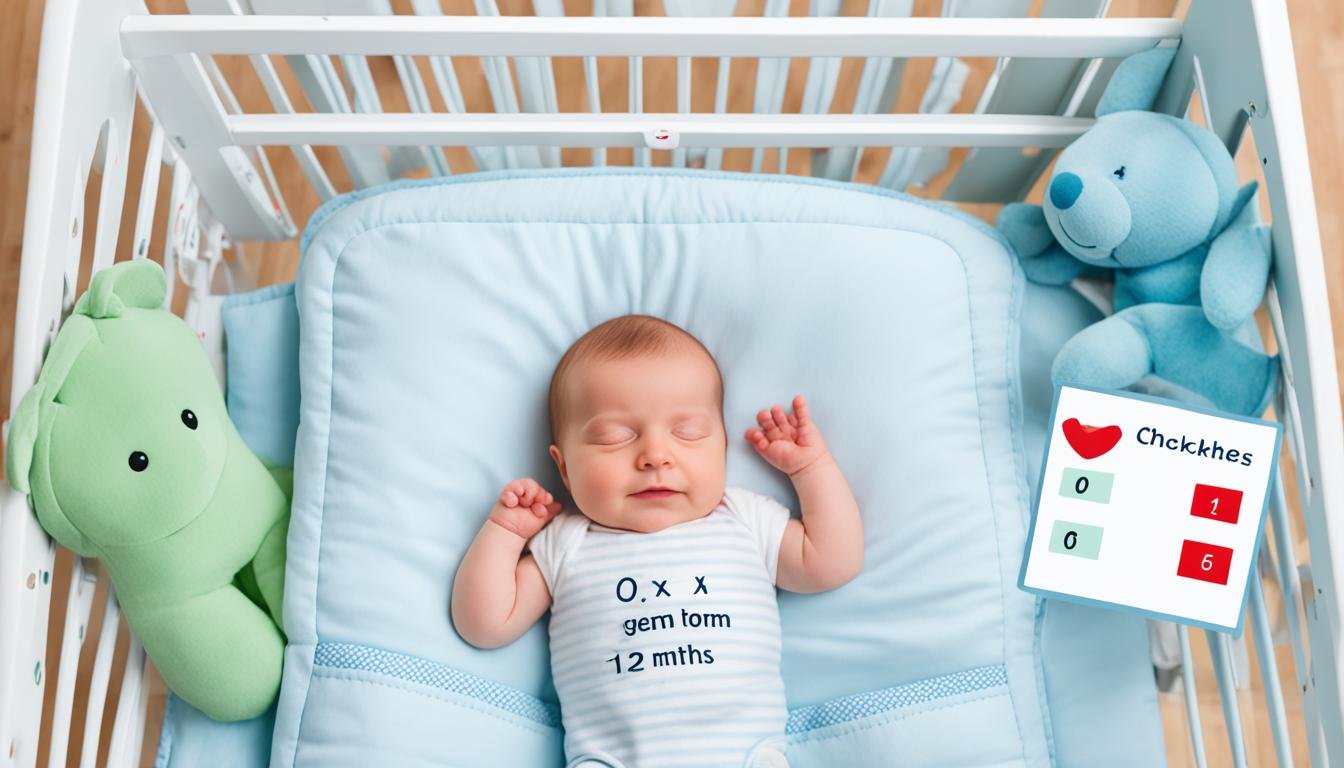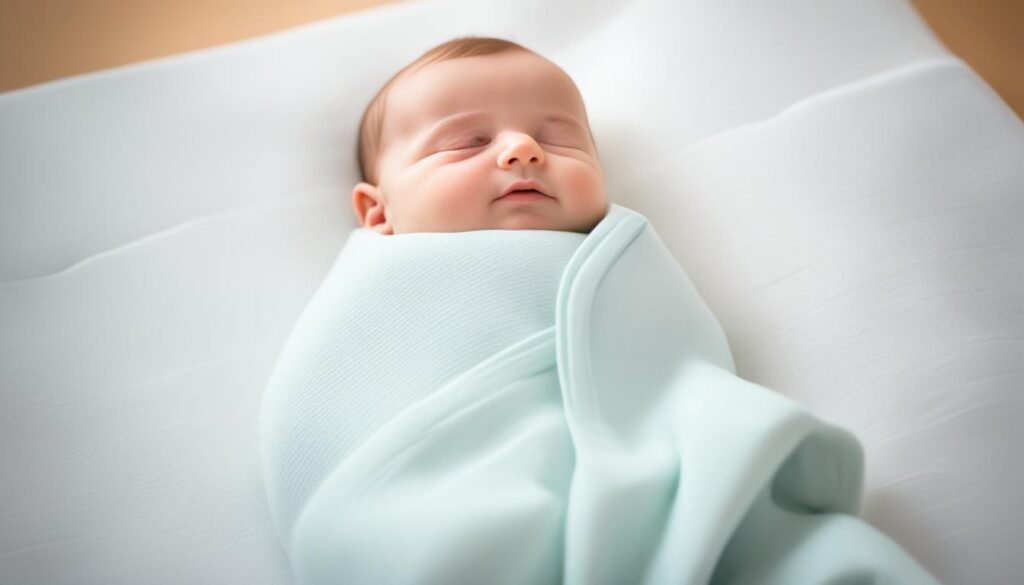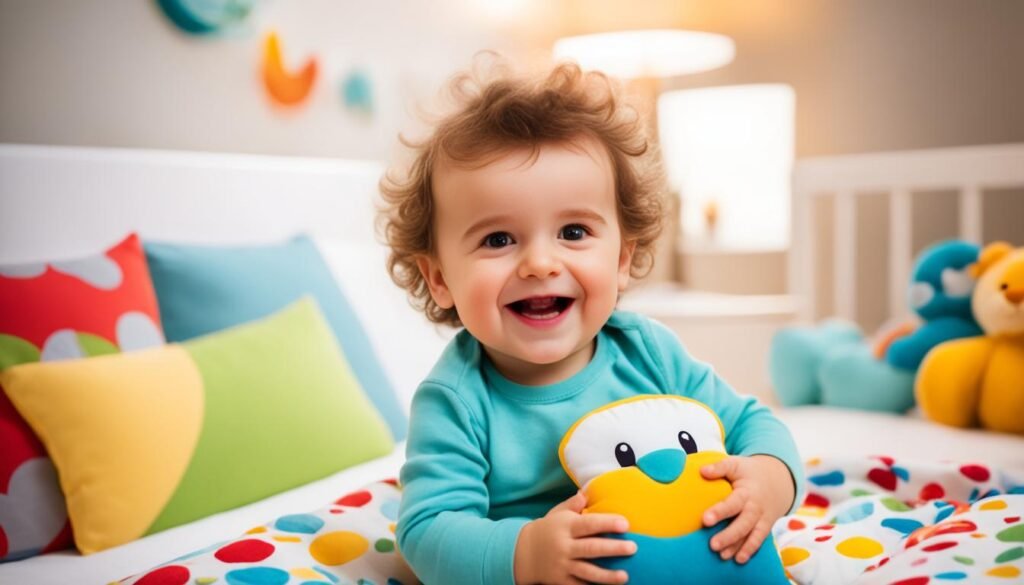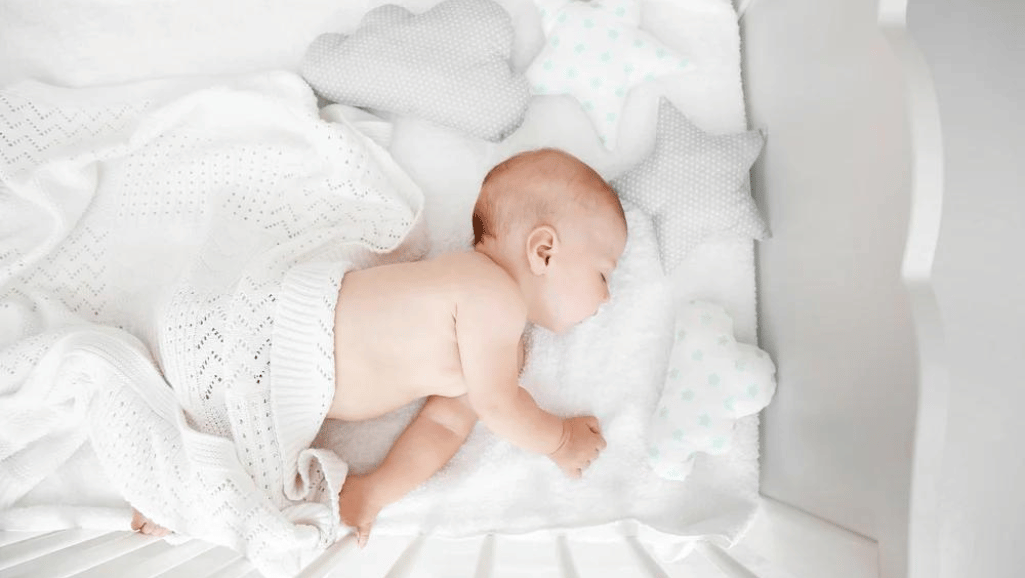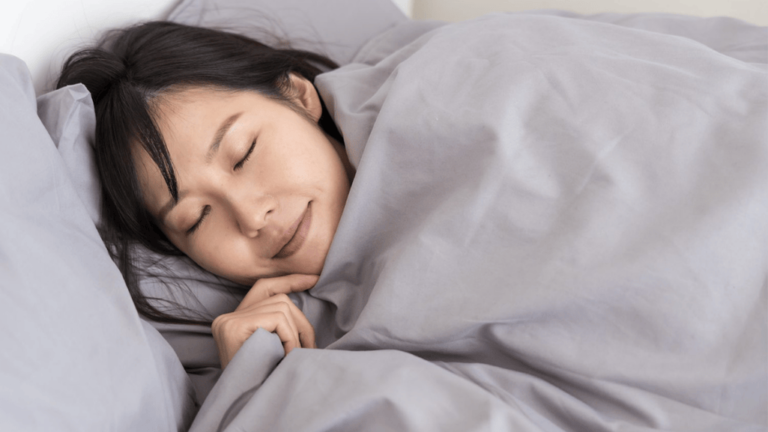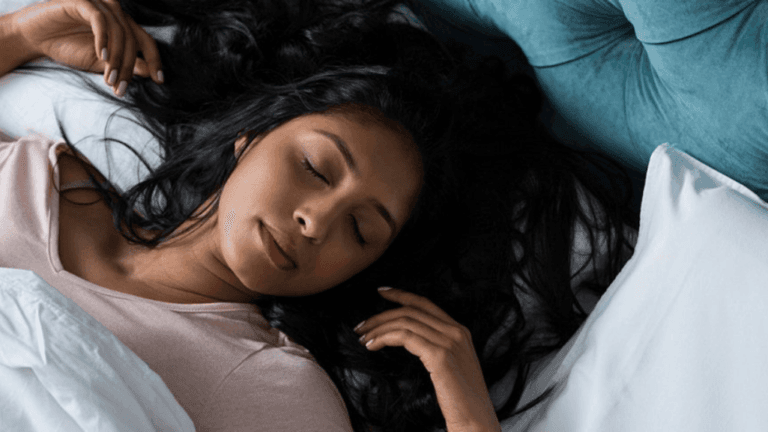New parents often wonder, when can babies have pillows? It’s vital for creating a safe sleep environment for infants. Respected experts like Dr. Harvey Karp, MD, FAAP, stress the importance of following infant sleep safety guidelines. They say infants shouldn’t have pillows until their first birthday. This is due to the danger of suffocation. The Food and Drug Administration also warns against certain baby pillows, as they can lead to unsafe sleep and even death.
Infant sleep safety guidelines recommend using only a fitted crib sheet. This helps reduce the risk of overheating and SIDS. It’s important to keep the sleeping area simple and safe. As babies turn one and start growing out of that critical SIDS period, you can slowly start adding pillows and blankets. This is usually around their second or third birthday when they move to a bigger bed.
Key Takeaways
- Introduce pillows only after the first birthday once SIDS risks decrease substantially.
- Ensure a child is at least 2 years old and transitioning from a crib to a bed before pillow introduction.
- Opt for hypoallergenic materials in sleep products to avoid allergies or skin irritation.
- Choose small, flat, firm pillows for proper support of a developing toddler’s neck and spine.
- Follow SIDS prevention tips such as removing all loose items from infants’ cribs.
- Consider a child’s readiness for a pillow based on their behavior, such as propping up with other items.
- Prioritize a crib with nothing but a fitted crib sheet to minimize initial suffocation risks.
Pillows in Infancy: What Parents Need to Know
Pillow safety for babies is critical in the first stages of being a parent. The American Academy of Pediatrics (AAP) warns against using pillows, loose blankets, and soft bedding for babies. They say this can prevent risks like suffocation, overheating, and Sudden Infant Death Syndrome (SIDS).
Here’s why pillows are not on the list for safe bedding for infants:
- Babies under one year old should not have pillows because of the risk of suffocation.
- Guidelines for safe sleep suggest using a firm, flat mattress without soft objects to lower the SIDS risk.
- By law, crib bumpers cannot be sold due to the dangers they bring, further emphasizing the risks of items in cribs.
When your child moves to a toddler bed, which usually happens between 18 months and 3.5 years, pillows can be considered. This should be a slow process, following advice on newborn sleep essentials. Safety and comfort are top priorities during this phase.
| Age | Bedding Recommendation | Risk Consideration |
|---|---|---|
| 0-12 Months | Firm, flat surface; no pillows | Prevents suffocation and SIDS |
| 12-18 Months | Start transition; consider small, firm pillow | Reduces risk of climbing and falling |
| 18 Months-3.5 Years | Introduction of suitable toddler pillows | Supports neck without misalignment |
This table shows how baby bedding should change as they grow. It’s key to use safe sleep practices at each step. This protects your child’s safety and health.
In summary, following advice on pillow safety for babies and ensuring a safe bedding for infants setup can make early care safer. It cuts down the dangers new parents might worry about.
Understanding SIDS and Pillow Safety for Babies
Learning about a safe sleep environment for infants is key for new parents. It helps create a safe space for babies to sleep deeply. This also lowers the risk of Sudden Infant Death Syndrome (SIDS).
Defining SIDS and Its Implications
SIDS is the tragic loss of a baby, often during sleep, with no clear cause. It’s usually linked to unsafe sleep conditions. To prevent SIDS, it’s advised to keep pillows, blankets, and toys out of the crib. Studies have shown this can cut down SIDS cases by 80%.
Creating a Safe Sleep Environment
Following infant sleep safety guidelines is important for reducing SIDS risks. It’s best to use a firm mattress with only a fitted sheet and no other bedding. Let’s look at why these rules are in place:
| Action | Impact on SIDS Prevention |
|---|---|
| Back-sleeping for infants | Significantly lower risk of sudden, unexpected infant deaths |
| Room sharing without bed-sharing | Can decrease the risk of SIDS by up to 50% |
| Use of a pacifier during sleep | Linked to lower incidences of SIDS |
| Breastfeeding | Recommended as the sole nutrition for at least 6 months to reduce SIDS risks |
| Smoke-free environment | Decreases potential SIDS risks when both prenatal and postnatal exposure is minimized |
It’s also crucial to pick newborn sleep essentials for safety above all else. And remember, as your baby grows, adjust their sleep area to keep them safe.
The Right Time: When Can Babies Have Pillows
Knowing when it’s okay for a baby to start using a pillow is key for their safety. The American Academy of Pediatrics says not before 2 years old. This advice is to keep the sleeping area safe. It lowers the chances of suffocation and Sudden Infant Death Syndrome (SIDS).
Using a pillow too early, even before moving from a crib to a bed, is risky. After 12 months, having a pillow in the crib is dangerous. It can help a baby or toddler climb, leading to falls or not being able to breathe.
When is it time for your child to have a pillow? Look at how they sleep and make sure they are in a toddler bed. This change is usually from 18 months to 3 1/2 years. It matches when the risk of SIDS is less.
A good pillow for toddlers is one that is small, thin, firm, and safe for allergies. This type supports their growth without putting them at risk. It keeps their sleeping spot safe and helps them sleep soundly.
In short, wait until your child is in a toddler bed and follow the expert advice on pillows. This avoids lots of sleep dangers. Always pick safety over looks or what’s easy when setting up a young child’s sleep space.
What Pediatricians Want You to Know About Infant Sleep Safety
Pediatricians strongly support infant sleep safety guidelines to keep babies safe. Infants should sleep without bedding, pillows, and toys to lower the risk of SIDS. Following these steps early on can greatly reduce dangers in an infant’s sleep area.
It is crucial to keep the crib simple, as infant sleep safety guidelines state. Except for a snug crib sheet, don’t add anything. This approach ensures a safe sleep space. It helps prevent SIDS, injury, and suffocation from sharing a bed.
More info on safe infant sleep shows that adding pillows too soon is risky. Top doctors say to wait until a child is two for a pillow. This age is when they might move from a crib to a bed, and it’s safer then.
| Age | Bedding Recommendation |
|---|---|
| 0-12 Months | No pillows, blankets, or soft toys |
| 12-24 Months | Continue with minimal bedding; assess individual readiness for changes |
| 2 Years+ | Introduction of a firm pillow and light bedding upon transitioning to a bed |
- Flat head syndrome means the baby’s head is flat on one side. Changing the head position during sleep and more tummy time can help. Using pillows or wedges is not the answer.
- To prevent and treat flat head, try moving the baby’s head while sleeping. Tummy time and repositioning the crib help without using pillows or wedges.
Safe bedding for infants is a must. Parents should keep watching and changing the sleep area as the baby grows. Always stay alert for new hazards until they’re safe for the baby.
The Transition from Crib to Pillow: Guidelines for Parents
Switching from a crib to a toddler bed is a big step for your little one’s growth. Adding a pillow even later is important too. Introduce these changes slowly to keep your child safe and comfy.
Selecting the Appropriate Bedding for Toddlers
It’s key to pick safe bedding for infants and toddlers. Choose a small, firm, and flat pillow to keep them safe from suffocation yet support their neck. Make sure it’s hypoallergenic and without treatments to prevent allergies or irritations. All bedding must also meet safety standards, like the Safe Sleep for Babies Act, to avoid potential sleep hazards.
How to Tell If Your Child Is Ready for a Pillow
Deciding the best age for baby to use pillow is all about their growth. Usually, kids are ready at about 2 years old. But, see if your child shows they need one by using a blanket under their head or a stuffed animal. It’s important to introduce it slowly. This way, it fits easily into their sleep routine.
Learn more about pillow safety for babies to get fully ready for this step.
| Age | Recommended Bedding | Notes |
|---|---|---|
| 0-12 months | Firm, flat mattress | No pillows or soft objects as per AAP guidelines. |
| 12-24 months | Transition to toddler bed | Consider toddler-sized, firm pillow if showing readiness. |
| 24+ months | Toddler pillow | Introduce a small, flat pillow if child expresses interest. |
Picking the Perfect Pillow: Safe Bedding for Infants
Choosing the right bedding for infants is key for new parents. The American Academy of Pediatrics advises against pillows for babies. This is to lower the chances of Sudden Infant Death Syndrome (SIDS) and suffocation.
The best age for baby to use pillow falls between 18 months and 3.5 years. This time matches when they move from a crib to a toddler bed. Safe bedding for infants means keeping their sleep space simple. This includes a firm mattress and avoiding loose or soft bedding.
When it’s time for a pillow, choose carefully. An ideal toddler pillow is flat, firm, and small. It’s made to support the neck without being too big for a toddler. Remember, safety is key. Big or fluffy pillows may look cozy but they’re risky for little ones.
| Product | Description | Age Recommendation |
|---|---|---|
| Newborn Crib Mattress | Firm surface tested to Greenguard’s Gold Standard. | 0-12 months |
| Toddler Pillow | Small, flat, firm pillow designed for toddlers. | 18 months – 3.5 years |
| Newton Baby Crib Mattress | Washable and certified for low emissions; made with Wovenaire core. | 0-18 months |
| Baby Lounger | Supports babies in sitting or tummy time; not for sleep. | 0-6 months (not for sleep) |
It’s crucial to follow these newborn sleep essentials guidelines. This ensures a safe place for your baby to sleep. It also helps reduce risks in the early months.
Newborn Sleep Essentials: Avoiding Common Sleep Hazards
Making a safe sleep space for babies is key for their growth and well-being. Doctors and safety pros stress knowing what’s safe in a crib is very important. This means keeping out things like pillows, bumpers, and soft toys.
Crib Safety: What Should and Shouldn’t Be Inside
Keeping your baby’s crib safe helps avoid dangers like Sudden Infant Death Syndrome (SIDS). Only a fitted sheet should be in the crib. Avoid using pillows, bumpers, or blankets. They can increase the risk of SIDS because they might cause babies to stop breathing.
Optimal Sleep Conditions for Newborns
The ideal sleep area for a baby is simple and clean. Use just a firm mattress covered with a sheet in the crib. No extra bedding or items should be there. This keeps the baby safe and helps them sleep well.
Newborn sleep essentials are more than just for comfort. They protect against SIDS. The American Academy of Pediatrics recommends these safety steps.
The Newton Baby Crib Mattress is a great choice for safety. It uses a unique Wovenaire core for better airflow. This, along with proper sleep habits and placing babies on their backs, lowers the chance of sleep risks.
It’s crucial to follow these essential tips for newborn sleep. They make the sleep area safer and cut down on sleep dangers. This is key for a baby’s health and development.
From Crib to Toddler Bed: Introducing Your Child to Pillows
Moving from a crib to a toddler bed is a big step for your child. They start to feel more grown up and comfortable in their room. Many parents think about adding a pillow at this stage. But, it’s very important to do this carefully to keep your child safe.
Experts say to wait until your child is 2 years old before giving them a pillow. They suggest this because younger children might not have the skills needed. With pillows, there’s a small chance they could accidentally cover their face and get hurt. Safety always comes first, which is why it’s best to wait.
| Age | Recommendation | Risks |
|---|---|---|
| 0-12 Months | No pillows or soft bedding | High risk of SIDS and suffocation |
| 12-24 Months | Evaluate readiness for a pillow | Potential for suffocation if not ready |
| 24+ Months | Introduce small, firm pillow if ready | Lower risk, focus on comfort and safety |
Choosing the right pillow is key to keeping your child safe. A small, firm pillow is the best choice. It should be supportive yet soft. It’s also wise to pick a pillow made from safe, anti-allergy materials.
How do you know if your child is ready for a pillow? Look for signs like if they use blankets or toys to support their head. If you notice this, it might be time to introduce a proper pillow.
So, by considering expert advice and watching your child for signs, the move from crib to bed can be safe and easy.
Tailoring Toddler Bedding: Best Age for Baby to Use Pillow
Choosing the right bedding is key as your baby becomes a toddler. The toddler bedding guide says picking the right pillow at the right time is crucial for comfort and safety. Knowing the best age for baby to use pillow creates a safer sleep space.
Finding the Right Pillow for Your Growing Child
When choosing a pillow for your child, size, firmness, and material matter. A firm, small pillow is best for toddlers. It supports their neck well and won’t cause suffocation. Big, fluffy adult pillows are not safe for young kids. The Urban Infant Pipsqueak Small Pillow is a great choice. It’s small and firm, perfect for toddlers.
Age-Specific Recommendations for Pillow Introduction
Experts at the American Academy of Pediatrics recommend waiting until your child is 24 months old before introducing a pillow. This advice aims at keeping children safe. Parents should look at the child’s growth, moving from a crib to a bed, and sleep habits when deciding about pillows. Most kids start showing they want a pillow around this age.
While it might seem easy to add a pillow, safety and guidelines are important. Following the set age rules keeps your child safe from certain dangers, like suffocation. Stick to simple and minimal bedding at first. As kids get older, you can introduce more tailored bedtime items for better sleep.
Guidance on Baby Sleep Products: Pillow Safety for Babies
In the wide world of baby sleep products, safety should be a top concern for parents. This is especially true for pillows. Pillow safety for babies is key, with experts warning against using pillows. They say this helps lower the risk of SIDS, or sudden infant death syndrome.
The American Academy of Pediatrics recommends babies sleep on a firm, flat surface. They should not have pillows, blankets, or soft bedding with them until at least one year old. This advice is to reduce SIDS and other dangers. As for pillows, wait until the baby moves to a toddler bed, between 18 months and 3 and a half years.
- Use a small, firm pillow meant for babies or toddlers, not an adult-sized one.
- Sheets in the crib or bassinet should be the only bedding, until the child is 12 months old.
- When you move to a toddler bed, choose pillows that are flat and firm to stay safe.
For in-depth advice on baby product safety, check out What to Expect’s pillow safety section. It provides more details and expert advice to help you make safe choices.
The Safe Sleep for Babies Act in the U.S. is important. It stops the sale and making of crib bumpers, known to be risky. Knowing these laws helps keep your baby safe and legal.
It’s vital to follow baby sleep product guidelines carefully. By choosing safe products and using them correctly, parents can make their baby’s sleep environment much safer. This is critical for their first few months of life and beyond.
SIDS Prevention Tips: Protected Sleep From Newborn to Toddler
Keeping an safe sleep environment for infants is key in preventing Sudden Infant Death Syndrome (SIDS). A big part of SIDS prevention tips is making sure a baby’s crib has no pillows, blankets, or toys. Studies show these steps can lower SIDS by 80%. Let’s look at how to create a safe sleeping area for babies at each stage, from newborns to toddlers.
One crucial step is to have babies sleep on their backs for their first year. This is the safest way and can decrease SIDS risk a lot. Sleeping on the back is much safer than on the stomach or side, which can make SIDS more likely.
| Age Group | Safe Sleep Practices | Risks Avoided |
|---|---|---|
| Under 1 Year | Back sleeping, no pillows or toys in crib | SIDS, suffocation |
| 1 to 2 Years | Consider transitioning to bed, monitor readiness for pillow | Suffocation, falls from crib |
| Over 2 Years | Small, firm pillow, own sleep space | Reduced SIDS risk, better sleep hygiene |
The American Academy of Pediatrics (AAP) suggests avoiding pillows in a toddler’s bed until they’re 2. Watching how your toddler handles soft items can show you when they’re ready for a pillow. A small, thin, and firm pillow is best to keep the sleeping area safe as they get older.
Good sleep safety can save lives and includes air quality, room temperature, and a firm mattress. Room sharing is better than bed-sharing, as it keeps infants close to parents without the added dangers.
Sticking to these SIDS prevention tips can reduce SIDS risk and offer health benefits through good sleep practices. It’s important for parents and caregivers to keep up these behaviors from the newborn stage through toddler years for a peaceful and secure night sleep.
Conclusion
When can babies have pillows? This question is all about keeping kids safe during their long sleep times. Babies sleep a lot, from 12 to 14 hours daily. Experts like the American Academy of Pediatrics (AAP) and studies in the Journal of Pediatric Healthcare give advice. They say to use pillows made for toddlers. These pillows are small and made just for kids. They’re about 13×18 or 12×19 inches. Toddler pillows help little ones sleep safely and keep their backs healthy.
Safe bedding for infants is crucial to prevent SIDS. Groups like the Environmental Working Group (EWG) push for using safe, natural bedding. They warn against using pillows for babies under 1 year old. This warning is because of many babies dying from not breathing while they sleep. The number of baby deaths has been going down, thanks to safer bedding over the years. This change shows that more people are learning how to keep babies safe while they sleep.
It’s important to keep babies safe. More babies are surviving thanks to following safer sleep rules. The right time to introduce a pillow is when kids are 18 to 24 months old. This is typically when they move to a toddler bed. Following these careful rules makes sleeping safer, even from a very young age. Parents and caregivers can ensure their babies sleep safely. With the right knowledge, they can avoid dangers once common for our littlest ones.

